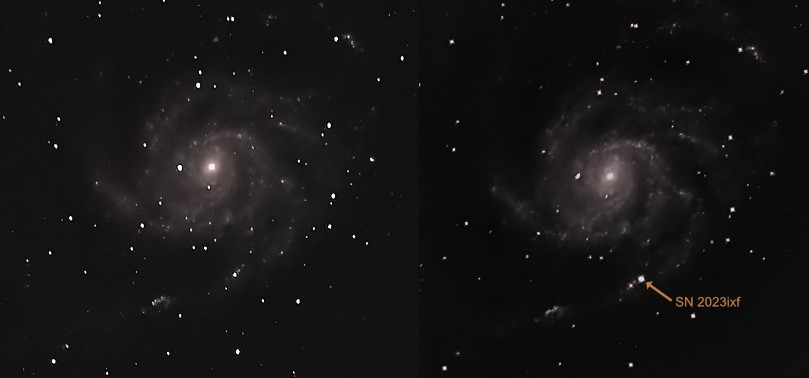M101
Pinwheel Galaxy in Ursa Major

10.1” f/4.5 Mallincam DS432cTEC
Exposures = 5-10-15-15 sec, Live-stacked frames = 30-30-30-20 (110 total), Gain = 25 of 250, Whitepoints = 255-255-255-175
A beautiful face-on spiral, M101 immediately appears very large in the view and it doesn’t take long for the spiral arms to reveal themselves. A number of other NGCs can be seen in this image; NGC 5461 and 5462 are ionized hydrogen regions that appear as brightish smudges of nebula in the lower spiral arm at 5:30 and 7 o’clock respectively. NGC 5471, another HII region, appears as the brightest “star” further down the 7:00 line. Another appearing as a star is NGC 5455 at 3 o’clock in the dim extremities of another spiral arm, and there are more HII regions appearing in the spiral arms above the core. Overall the apparent size of the galaxy is about 20 arc minutes; it’s listed as 170,000 light years across or about twice the size of the Milky Way, with 1 billion suns, and about 21 million light years away.
North is at 9 o’clock, East at 6 o’clock
Supernova SN 2023ixf

Type II supernova SN 2023ixf was discovered in M101 by amateur astronomer Kōichi Itagaki on May 19th 2023; the image on the right I took 9 days later on May 28th. At the time it was around magnitude 11. I happened to take the image on the left 6 weeks earlier on April 14th. Comparing the two you can see the supernova location previously did not show anything.
Before and after SN 2023ixf


(hover/click over image)
M101 with Supernova SN 2023ixf

10.1” f/4.5 Mallincam DS432cTEC
Exposures = 5-20 sec, Live-stacked frames = 15-65 (75 total), Gain = 15 of 250
May 28, 2023 02:40 to 03:01 UTC
Close-up of the May 28th supernova image.
North is at 9 o’clock, East at 6 o’clock